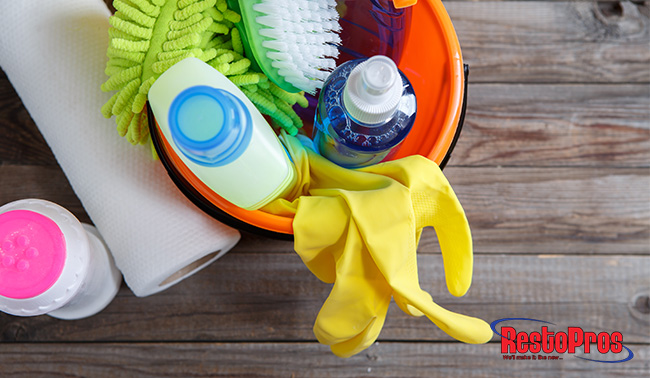
Mold is a common and frustrating problem that many homeowners deal with daily. Often, they ask if they can remove it on their own using DIY methods. That depends on the size of the area the mold is covering and the extent of the damage it has caused. Usually, if its in a small, easy to clean area, you can remove it by yourself. To help you out, here are some effective DIY mold removal tips from the team at RestoPros!
1. Do Your Research
Whenever you take on a home service project, it’s important to do your research and be prepared. If you just jump in without any information, preparations and precautions you will just be making things harder for yourself.
When doing research, look into the Environmental Protection Agency’s guidelines regarding DIY mold removal. According to the EPA, if the moldy area is less than 10 square feet or roughly within a three feet by three feet patch, you can tackle the mold problem yourself. However, if there has been extensive water damage or the moldy area is larger than 10 square feet, it’s best to call a professional. In addition to guidelines, the EPA also has great mold removal tips and techniques to help you safely remove mold from your home.
Another thing you should know before you remove mold is what to wear. Make sure you have long, rubber gloves on and goggles that don’t have ventilation holes. In addition, you can wear an N-95 respirator to avoid inhaling mold spores—this is especially helpful if you have mold allergies or are prone to allergies in general.
2. Baking Soda, Vinegar and Hydrogen Peroxide Are Your Best Friends
Alright, you have done your research and you have concluded that you can handle the mold on your own. The next thing you need to know is that baking soda, vinegar and hydrogen peroxide are great natural mold killers. Here are some ways you can use them:
- Baking Soda
Simply add one-quarter or one-half tablespoon of baking soda to a spray bottle containing water. Then, shake the bottle until it’s dissolved. Spray the affected area with the solution and let it sit for a few minutes. Scrub the area until the mold is gone and rinse the area.
- Vinegar
Pour distilled white vinegar into a spray bottle without watering it down. Spray the vinegar onto the mold surface and let it sit for about an hour. Then, scrub and wipe the area clean with water and let the surface dry.
- Hydrogen Peroxide
This solution is a great bacteria killer. Pour three percent concentration hydrogen peroxide into a spray bottle then spray the entire moldy area. Let it sit for 10 minutes. Then, scrub the mold away, rinse it off and wipe it dry.
3. Spray and Scrub to Remove Exterior Mold
We’ve talked a lot about mold growing inside your home. However, mold can also grow on the exterior of your house as well and it can cause significant damage to your home by eating away at the wood and even sneaking into the inside of your home.
To remove mold from the exterior surfaces of your home and spray a very diluted bleach solution (1-to-10 solution of bleach and water) on the affected area. Then scrub any stains with a stiff bristle brush dipped in solution. Let the solution sit for 20 minutes and rinse with a garden hose.
4. You Might Have to Dispose of Some Items
Keep in mind, this might not be necessary when only a very small portion of your home has been affected by mold. However, some porous surfaces such as carpets may have to be thrown away if they become moldy. Even if it doesn’t look so bad on the surface, mold spores can show up in tiny cracks and crevices of porous items and it might be impossible to get rid of the mold entirely.
RestoPros: Experts in Mold Removal
If mold doesn’t seem to go away no matter what you do, you might have to call a professional. Look no further than RestoPros! We offer services such as mold testing, mold remediation and water damage restoration. Our well-trained and knowledgeable experts will make sure your home is 100 percent mold free! Get in touch with us today by calling 855-587-3786 or by filling out a service request form
